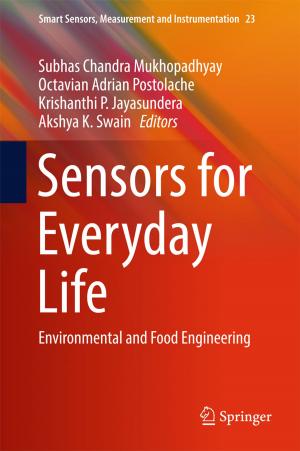Biomedical Signals and Sensors III
Linking Electric Biosignals and Biomedical Sensors
Nonfiction, Science & Nature, Science, Biological Sciences, Biophysics, Technology, Engineering| Author: | Eugenijus Kaniusas | ISBN: | 9783319749174 |
| Publisher: | Springer International Publishing | Publication: | August 14, 2019 |
| Imprint: | Springer | Language: | English |
| Author: | Eugenijus Kaniusas |
| ISBN: | 9783319749174 |
| Publisher: | Springer International Publishing |
| Publication: | August 14, 2019 |
| Imprint: | Springer |
| Language: | English |
As the third volume in the author’s series on “Biomedical Signals and Sensors,” this book explains in a highly instructive way how electric, magnetic and electromagnetic fields propagate and interact with biological tissues. The series provides a bridge between physiological mechanisms and theranostic human engineering. The first volume focuses on the interface between physiological mechanisms and the resultant biosignals that are commonplace in clinical practice. The physiologic mechanisms determining biosignals are described from the cellular level up to the mutual coordination at the organ level. In turn, the second volume considers the genesis of acoustic and optic biosignals and the associated sensing technology from a strategic point of view. This third volume addresses the interface between electric biosignals and biomedical sensors. Electric biosignals are considered, starting with the biosignal formation path to biosignal propagation in the body and finally to the biosignal sensing path and the recording of the signal. The series also emphasizes the common features of acoustic, optic and electric biosignals, which are ostensibly entirely different in terms of their physical nature.
Readers will learn how these electric, magnetic and electromagnetic fields propagate and interact with biological tissues, are influenced by inhomogeneity effects, cause neuromuscular stimulation and thermal effects, and finally pass the electrode/tissue boundary to be recorded. As such, the book helps them manage the challenges posed by the highly interdisciplinary nature of biosignals and biomedical sensors by presenting the basics of electrical engineering, physics, biology and physiology that are needed to understand the relevant phenomena.
As the third volume in the author’s series on “Biomedical Signals and Sensors,” this book explains in a highly instructive way how electric, magnetic and electromagnetic fields propagate and interact with biological tissues. The series provides a bridge between physiological mechanisms and theranostic human engineering. The first volume focuses on the interface between physiological mechanisms and the resultant biosignals that are commonplace in clinical practice. The physiologic mechanisms determining biosignals are described from the cellular level up to the mutual coordination at the organ level. In turn, the second volume considers the genesis of acoustic and optic biosignals and the associated sensing technology from a strategic point of view. This third volume addresses the interface between electric biosignals and biomedical sensors. Electric biosignals are considered, starting with the biosignal formation path to biosignal propagation in the body and finally to the biosignal sensing path and the recording of the signal. The series also emphasizes the common features of acoustic, optic and electric biosignals, which are ostensibly entirely different in terms of their physical nature.
Readers will learn how these electric, magnetic and electromagnetic fields propagate and interact with biological tissues, are influenced by inhomogeneity effects, cause neuromuscular stimulation and thermal effects, and finally pass the electrode/tissue boundary to be recorded. As such, the book helps them manage the challenges posed by the highly interdisciplinary nature of biosignals and biomedical sensors by presenting the basics of electrical engineering, physics, biology and physiology that are needed to understand the relevant phenomena.















